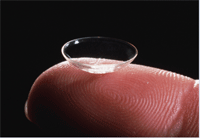• Optovue’s RTVue has received FDA 510(k) clearance for OCT measurements of central corneal power, curvature and thickness in human corneas, both pre- and post-cataract surgery. It can also calculate total cornea power in eyes that have undergone corneal refractive surgery. For more information, visit www.optovue.com.
• According to a recent study in Optometry and Vision Science, protein and lipid deposits on contact lenses may contribute to clinical complications. It examined the effect of phospholipids on the adhesion of bacteria to contact lenses. Results showed that while phospholipids adsorb/absorb to contact lenses during wear, the major types of phospholipids adsorbed to lenses do not alter bacterial adhesion or growth.
• Bausch + Lomb has added a new product to its signature loteprednol etabonate line: Lotemax Ointment — indicated to treat postoperative inflammation and pain following ocular surgery. Lotemax Ointment is the first preservative-free topical ophthalmic steroid formulation in the U.S. For more information, visit www.bausch.com.
• ABB CONCISE and Compulink Business Systems, Inc., have announced a partnership to integrate Compulink’s leadership Electronic Health Records (EHR) and Practice Management software with ABB CONCISE’s distribution centers. As part of this partnership, users of Compulink’s Eyecare Advantage software will now be able to order lenses directly from ABB CONCISE’s catalog of products. For more information, visit www.abbconcise.com.
Steroids Could Help Heal Corneal Ulcers
Arecent study gives hope to those suffering from severe cases of bacterial corneal ulcers, which can lead to blindness if left untreated. The use of topical corticosteroids in a randomized controlled trial was found to be neither beneficial nor harmful in the overall patient population in the study. However, it helped patients who had more serious forms of bacterial corneal ulcers, according to University of California, San Francisco researchers.
In a paper published in Archives of Ophthalmology, researchers found significant vision improvement—one and a half to two lines of improvement—by using steroid therapy on patients with severe ulcers.
The use of topical corticosteroids is somewhat controversial, with no specific evidence pointing one way or the other. But in this study–the Steroids for Corneal Ulcers Trial (SCUT)—co-author Nisha Acharya, MD, MS, says “There was no increase in cornea perforations.”
Dr. Acharya and his colleagues looked at 500 participants from the United States and India between September 2006 and February 2010. “It makes us feel like we’re moving towards an evidence-based paradigm of care for corneal ulcers rather than a trial-and-error sort of approach,” Dr. Acharya said.
Cause of Increased Infections in Contact Lens Wearers
While it is well documented that contact lens wearers have a much higher incidence of corneal infections compared to those who do not wear contact lenses, the exact cause of this increased susceptibility has not been identified. A recent study—published in Investigative Ophthalmology & Visual Science—was performed to determine if multipurpose contact lens solutions (MPCLSs) can cause increased infections in the cornea by destroying the protective cell-bound mucin layer.
 An immortalized human corneal-limbal epithelial cell line (HCLE) was treated in the presence of four commonly used MPCLSs and the expression and release of MUC-16 was assessed. Cells were also cultured with Pseudomonas aeruginosa following MPCLS treatment and internalization of bacteria was assessed by quantitative genomic PCR. Loss of MUC-16 was then correlated with infection rates.
An immortalized human corneal-limbal epithelial cell line (HCLE) was treated in the presence of four commonly used MPCLSs and the expression and release of MUC-16 was assessed. Cells were also cultured with Pseudomonas aeruginosa following MPCLS treatment and internalization of bacteria was assessed by quantitative genomic PCR. Loss of MUC-16 was then correlated with infection rates.
Each of the four commonly used MPCLSs examined in this study differentially affected mucin release. The relative effect was correlated with an increase in infection of corneal epithelial cells by P. aeruginosa. Study results are consistent with the hypothesis that MPCLSs cause increased infections in the cornea by destroying the protective cell-bound mucin layer.
Contamination Risk of Reusing Daily Disposable Contact Lenses
A new study in the November issue of Optometry and Vision Science investigated contamination of saline and daily disposable contact lens (DDCL) stored overnight after use in the original blister pack and studied the practices of a group of DDCL users. Twenty DDCL wearers placed their lenses back into the blister pack saline (BPS) after one day’s use and left them overnight before transferring both lenses and BPS to a new CL case.
The lens and BPS were cultured the following day, and total number of organisms, Staphylococci and gram-negative organisms enumerated. Each subject submitted five pairs of lenses over a one-month period. Ninety-five percent of subjects had at least one pair of contaminated lenses, and the BPS yielded similar results to the contaminated lenses, with staphylococcal contamination being predominant. Three subjects admitted to not washing their hands before handling their lenses and six to habitual reuse of their lenses with storage in the BPS.
Mercy Ships Celebrates World Sight Day
Approximately 80% of all visual impairment can be prevented or cured, according to the World Health Organization (WHO). On World Sight Day, Mercy Ships honored those patients who had received eye surgeries onboard the state-of-the-art hospital ship, the Africa Mercy.
In 2011, Mercy Ships eye surgeons gave the gift of sight to more than 1,300 individuals in Sierra Leone, one of the poorest countries in the world. The Mercy Vision Eye Care Team also performed more than 7,500 eye evaluations and distributed 2,400 pairs of reading glasses.
With approximately 90% of all visually impaired people living in developing nations, the medical services provided by Mercy Ships in West Africa are focused on the areas of greatest need. The Africa Mercy has six operating theaters, a CT scan, a laboratory, and an X-ray machine. For more information, visit
www.mercyships.org.


